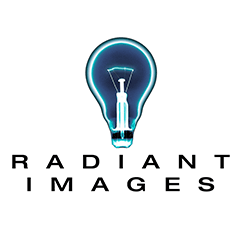
For Immediate Release
November 1, 2010
Contact:
Jason Wolfe, Wolfe PR
(520) 207-9581
E-mail: jason@wolfenews.com
Carrie Schreck, HD Camera Rentals
(415) 730 1146
Web Site: http://www.radiantimages.com
DIT Michael Mansouri of HD Camera Rentals Plays Key Role in Filming of Danny Boyle’s 127 Hours
Los Angeles-based HD Camera Rentals supplies cameras, custom equipment and expertise to 127 Hours, opening Nov. 5
LOS ANGELES (November 1, 2010)– While preparing to shoot 127 Hours, acclaimed director Danny Boyle and cinematographers Anthony Dod Mantle and Enrique Chediak discovered what a growing number of digital filmmakers already know:If you want to get the impossible shot, get Michael Mansouri.
Mansouri, a DIT who founded HD Camera Rentals (HD Camera Rentals) in Los Angeles in 2005, has quickly earned a reputation as an innovator and a problem solver in the new, fast moving world of digital cinema. His skills are evident in 127 Hours, which premieres in U.S. theaters on Nov. 5.
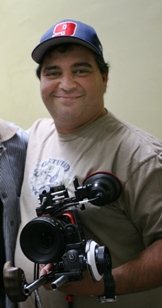 Mansouri helped take digital cinema technology to new heights in the film, much to the satisfaction of Boyle and Mantle, who were following up on their Academy Award-winning work on Slumdog Millionaire. In fact, many of the most creative shots in 127 Hours were the result of Mansouri finding a solution that enabled the DPs to get what they wanted how they wanted it.
Mansouri helped take digital cinema technology to new heights in the film, much to the satisfaction of Boyle and Mantle, who were following up on their Academy Award-winning work on Slumdog Millionaire. In fact, many of the most creative shots in 127 Hours were the result of Mansouri finding a solution that enabled the DPs to get what they wanted how they wanted it.The movie, starring James Franco, tells the story of Aron Ralston, an adventurous hiker who spent 127 hours after an accident in the Utah desert pinned by a boulder in a deep crevice before deciding to amputate his own arm to escape and save his life.
Mansouri recently spoke about his involvement in 127 Hours, his approach and the keys to the rapid rise of HD Camera Rentals as the “go to” rental house in the digital film industry.
Q: How did you get involved in 127 Hours?
A: We were contacted by 127 Hours after someone there learned of our work on an AT&T spot during the Winter Olympics. In that spot, we figured out how to strap a tiny SI-2K POV camera and a Cinedeck recorder onto an Olympic ski jumper who did a 120-meter jump while wearing the apparatus. It was an amazing shot. Since we had so much experience with the SI-2K, the team from 127 Hours called us in to see what we could do for them. During our meeting, Danny (Boyle) and Anthony (Dod Mantle) discussed potential issues and challenges that they had about the shoot, what they were hoping to be able to do, and we presented them with some ideas and solutions. We showed them military-grade laptops, the Cinedeck system, cage designs, all the things you think about later. We explained some of the ways we had improved the SI-2K, way beyond what they had used in filming Slumdog. They liked what they heard and we were hired. I remember Danny saying at one point that they wished they had had us for Slumdog.
Q: What do you think impressed them about HD Camera Rentals?
A: They saw that we are a company that understands digital technology and is willing to put in the time and effort to find customized solutions. We don’t believe in the cookie cutter approach. We assess the clients’ needs and then we resolve the issues that are unique to them. If that means engineering a new piece of equipment, reconfiguring a camera, whatever, we do it. I’m assuming they recognized what we were capable of and our willingness to do what needed to be done.
Q: How did you prepare for the shoot?
A: With the help of my brother, Bobby Mansouri, we spent almost a month in R & D responding to a long list of demands from Danny and Anthony. We custom built handheld rigs. We also built a special cage for Anthony. We even laser engraved his name on it. It was a multipurpose cage, allowing us to mount the camera anywhere, and it also had a power distribution box so that we could power many things off of it. This was done in response to one of the weak points with digital – all the cables everywhere. We resolved that by removing all the connectors on the camera, like the manufacturer’s VGA and USB connections. We changed all those to professional Lemo connections and made the power source tap right into the sensor.
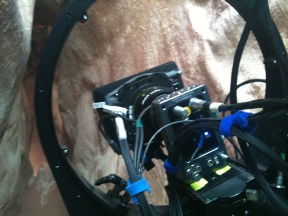 We focused on keeping everything as clean and simple as possible. Anthony wanted a simplified set-up, which to me is the whole essence of digital anyway. Digital should offer people things that film can’t. It should be smaller, faster and should provide immediate gratification.
We focused on keeping everything as clean and simple as possible. Anthony wanted a simplified set-up, which to me is the whole essence of digital anyway. Digital should offer people things that film can’t. It should be smaller, faster and should provide immediate gratification.Q: What were the specific challenges you faced in preparing for the shoot?
A: First of all, the remote location in Utah. We were shooting in the Moab Desert, a harsh environment with dust and extreme heat during the day, and cold at night. We also were shooting in tight quarters since most of the movie takes place in a deep, narrow crevice. Danny also wanted to work fast to give the shoot an immediacy and urgency to mirror the mood he was trying to create for the movie itself, which he accomplished. All those elements combined to create a special set of challenges.
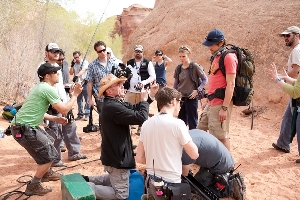 Q: Tell us about some of the solutions.
Q: Tell us about some of the solutions.A: I’m not sure where to start. We already had made a number of improvements to the SI-2K system to make it more compatible with filmmaking and less with consumer applications. When we brought all our different SI-2K rigs to the set Danny and Anthony were blown away. With the SI-2K/Cinedeck solution, they could record uncompressed files that were ready for immediate viewing on set through QuickTime without a transcoding step. They loved how integrated the entire system was and how fast it moved.
We also presented them with autofocus systems to handle some of the shots that were really hard to focus on. The lens control took over and controlled the focus.
Anthony wanted everything as small as possible. They had replicated exactly the deep crevice where Aron Ralston got his hand caught, so we needed to shoot in an extremely narrow and tight space. So Bobby and I made a rig to fit the space. Only the absolutely essential equipment could be there. We stripped a camera down to its bare sensor and ran 250 foot cables from it back to a recording device where the techs could pull focus and give feedback to the cinematographer.
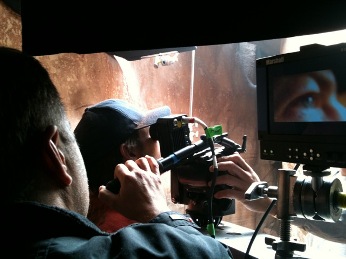 We also provided Anthony, based on his request, with a remote button on his handheld system that when he would trigger gave his eye piece certain information like his focus or his luminance levels. We had programmed all those in there for him. He also wanted specific shutters, so we were able to program those as well. A lot of that was achieved by changing the software inside the camera.
We also provided Anthony, based on his request, with a remote button on his handheld system that when he would trigger gave his eye piece certain information like his focus or his luminance levels. We had programmed all those in there for him. He also wanted specific shutters, so we were able to program those as well. A lot of that was achieved by changing the software inside the camera.Also, I guess I should tell you about a pretty elaborate shot quite early on. They wanted to mount the camera to travel off the side of the rocks in the crevice, go up to James Franco and follow him as he falls down. So how do you do that and control the small camera? We were able to make this remote control head that we suspended with cables with tilt and pan, and controlled its travel using a joystick.
Q: What equipment did HD Camera Rentals provide?
A: HD Camera Rentals supplied the shoot with eight SI-2K cameras as well as an assortment of Canon DSLRs and the IDT Redlake high-speed camera. Handheld rigs were customized to make sure they would hold up under demanding shooting conditions. Lens wise, we provided the new Arri Ultra 16s, which are super sharp, amazing lenses. We also shot with the full set of Schneider C-mount lenses and a full set of ‘L’ series lenses for the Canon cameras. And if you can believe this, we also shot with the Angenieux Optimo 24-290 on the SI-2K.
Q: What was the schedule like on set?
A: My brother Bobby and I remained on the set in Utah throughout the eight-week shoot. It was pretty remote. We were two hours away from cell phone coverage. Everything had to be helicoptered in. The film was shot sequentially, much of it in the actual canyon and a lot of it on a sound stage, where the crevice was re-created. It was an unusual arrangement with two cinematographers and two crews on set at the same time. They took turns shooting. When one was shooting, the other rested, and vice versa, so we were able to shoot seven days a week. Bobby and I ended up working pretty much around the clock with just a few days off. We constantly were testing cameras, showing the DPs different resolutions and magnifications. And when a challenge arose, which was pretty much every day, we worked to resolve it. We’d go to component stores and make fixes and build equipment right there. We were R&D on set. They’d say, “we can’t do that shot,” then two days later we’d have it resolved and they would get the shot. In filmmaking, the difference between great and good is who compromises the least. Anthony and Enrique completed the shoot with few compromises.
Q: What an interesting arrangement to have two DPs working on the same film. How did that shake out, equipment wise?
A: Both units were shooting SI-2Ks and the film had a total of six camera units at any one time. Each unit would have two cameras, sometimes three cameras, at the same time. Since the SI-2K has interchangeable lens mounts, filmmakers are able to use any lens they want to shoot on. On 127 Hours, we had cameras that were set up with Canon lenses on, PL mounts and C mounts and we could change them out without ever affecting anything. It was as easy as changing a lens. This arrangement allowed us to work fast.
Q: One problem with the tiny, lightweight movie cameras like an SI-2K is holding it steady. How did you deal with this?
A: We developed customized units with gyro-stabilization heads from Kenyon Labs that fit on the bottom of the SI-2K. As a result, camera operators were able to execute complex and dynamic moves in tightly constrained spaces. These cameras are not designed for the X and Y axis, tilt and roll, movement, so we made adapter mounts. Also, their design is constantly powered, but we made our design so we could hot-swap it. Because we’re also recording sound, we had to be able to disconnect them so they could still run without the noise of the gyros’ operation affecting dialogue. It was quite a challenge.
Q: What other steps did you take to deal with working in such tight spaces?
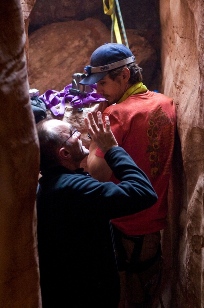 A: Well, because the space that Anthony was working in was so small, his camera assistant couldn’t work beside him, so wireless video and focus controls were needed so the AC wasn’t flying blind. We used a new touch screen LCD from C-Motion to transmit the signal wirelessly right into the monitor on the handheld system and include all the lenses and focus detail info. If Anthony had a really difficult shot, he hit auto-focus, the Cine Tape constantly took measurements and communicated directly to the motor. If he tilted to the left, and the subject was six feet away, and then he tilted to the right, and the subject was nine feet away, it automatically racked focus from six feet to nine feet and back.
A: Well, because the space that Anthony was working in was so small, his camera assistant couldn’t work beside him, so wireless video and focus controls were needed so the AC wasn’t flying blind. We used a new touch screen LCD from C-Motion to transmit the signal wirelessly right into the monitor on the handheld system and include all the lenses and focus detail info. If Anthony had a really difficult shot, he hit auto-focus, the Cine Tape constantly took measurements and communicated directly to the motor. If he tilted to the left, and the subject was six feet away, and then he tilted to the right, and the subject was nine feet away, it automatically racked focus from six feet to nine feet and back.Q: What were some of the issues you faced with data workflow?
A: Speed and redundancy were the keys to data workflow. To get the footage out of the Cinedeck and into the editorial workflow from the stage in Salt Lake, we used I Beyond Wrangler portable tapeless ingest systems to automatically verify the data and then copy the footage onto two removable hard disks, which were sent to Color Mill nearby. During the shoot, the data managers were parked on location in a trailer that was a two-hour drive from the nearest paved road and still a 15-minute helicopter flight from the set. They were parked right where the helicopter would land and we would send the drives to them so they could view the footage and let us know if there were any problems. Once the material was backed up, they would drive the disks over to Salt Lake City, where Color Mill would do dailies. That slowed us down a bit since the drive to Salt Lake took six or seven hours. But if there was a problem, we’d know within an hour, not within days.
That really was the key to this kind of workflow – if something goes wrong, it’s not a disaster if you know about it early enough to compensate on set. At one point, one of the solid-state drives failed and needed to be sent to a data recovery company. We didn’t lose any data in the end, but just in case some re-shots were done. That’s the spirit of digital, if there are any problems, you discover them before the shoot ends.
Q: Working with so many different cameras, can you talk about some of the issues you faced in that area, how you thought they performed, etc.?
A: The SI-2K is a remarkable camera, and I’m not only basing my opinion on the form factor, the size, the flexibility and the lenses, but on the image quality, which is the closest I’ve seen to film. Other digital cameras can be too sharp, too noticeably digital. The SI-2K also has some organic feel with a little bit of imperfection like analog. The other benefit is that it shoots uncompressed – you’re getting 2K, not 4K, but you’re getting it uncompressed and you’re getting a lot more bit depth and a lot more information and coloration. We were able to use the new version of software from the one that Anthony used on Slumdog and it’s a lot better apart from it being uncompressed. The Slumdog camera was 8:1 compression.
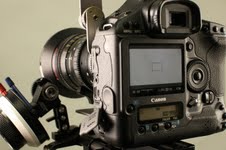 We also shot with Canons, the Canon EOS 5D Mark II as well as my favorite camera, the 1D Mark IV. Anthony got frustrated with the limitations with the video mode out of the Canon cameras. It’s a very compressed H.264 video file format, so it’s not ideal for the type of shooting he’s used to. We looked at it and tried to figure out ways to break the code and get uncompressed RAW out of the camera, but there was no way. What he ended up doing was shooting in still mode at 10 frame bursts and in post he would double it to 20 frames. The effect is interesting and will look really cool.
We also shot with Canons, the Canon EOS 5D Mark II as well as my favorite camera, the 1D Mark IV. Anthony got frustrated with the limitations with the video mode out of the Canon cameras. It’s a very compressed H.264 video file format, so it’s not ideal for the type of shooting he’s used to. We looked at it and tried to figure out ways to break the code and get uncompressed RAW out of the camera, but there was no way. What he ended up doing was shooting in still mode at 10 frame bursts and in post he would double it to 20 frames. The effect is interesting and will look really cool.The Canon cameras had their own set of challenges as they were really designed for still photography so we had to come up with some rigs to control the focus. We also faced challenges about how you monitor and how you get the director a video feed. We used the 1D Mark IV’s for a lot of high contrast, over exposed sunlight, snow caps, skin tones type shots since the camera could hold those shots in still mode.
Q: You had quite a collection of lenses available on the set, anything more you can tell us about them?
 A: We needed all these lens options as there were a couple of shots that Anthony really wanted that stretched our imagination. For one, he wanted to take the camera and go right into James Franco where he had his head inside of a sleeping bag and then go inside the sleeping bag. We made this special camera which was stripped down to the sensor with a handle on it. We were able to give him a HUD on the glasses that he wore so he could see the image on them. As a result, Anthony was able to take this really wide shot to show James Franco and bring the audience right in and feel the frustration that the actor is going through. It was amazing the kind of things we were able to do with the camera based on lens selection and ongoing philosophy of small and simple.
A: We needed all these lens options as there were a couple of shots that Anthony really wanted that stretched our imagination. For one, he wanted to take the camera and go right into James Franco where he had his head inside of a sleeping bag and then go inside the sleeping bag. We made this special camera which was stripped down to the sensor with a handle on it. We were able to give him a HUD on the glasses that he wore so he could see the image on them. As a result, Anthony was able to take this really wide shot to show James Franco and bring the audience right in and feel the frustration that the actor is going through. It was amazing the kind of things we were able to do with the camera based on lens selection and ongoing philosophy of small and simple.Q: Anything more you can tell us about other equipment that you used?
A: We had a lot of recorders. One was typical one you’d see at P+S Technik. Also, from General Dynamics we had true military grade laptops which were used in Desert Storm and can be battered and bruised without failing. The other system we had was the Cinedeck, an ultra-portable, cinema-grade monitoring, recording and playback device. We’re huge fans of this device. We were able to control our Cinedeck through Wifi so we were able to provide playback to the outside world during shooting inside the crevice, for example. Through that, we were able to offer on-set monitoring to iPads so the crew could watch what was going on. When I talk about immediate gratification, this is what I’m talking about.”
Also, when building our handheld rigs, we took a lot of our inspiration from the Aaton, the best handheld camera that we know. It fits so well it’s like a “cat on your back,” molding right against your shoulder. You can balance the camera with one hand. We took the Aaton handles and slid them on the cage so the camera could be held with one hand. We also devised the cage system so only one cable went to the camera. The monitor got powered from the cage, the cage got its power 150 feet away and the director could see wirelessly what was being shot.
Q: Are you satisfied with your work on 127 Hours?
A: Well, like anything, you look back and think about things you might have figured out sooner or some alternative fixes. But that said, I’m confident we made a real difference on this movie. I believe there would have been more limitations without us, and the movie would have taken longer to complete and been more expensive. The bottom line is, we enabled them to get the shots they wanted, so that’s gratifying.
Q: Are you interested in working with Danny Boyle again?
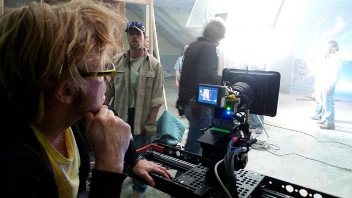 A: Are you kidding? We’d love to. I have nothing but the deepest respect for him and for Anthony Dod Mantle as filmmakers and as visionaries. They have embraced digital cinema and are taking filmmaking to some place new and fresh. I’d like to think we make a pretty good team.
A: Are you kidding? We’d love to. I have nothing but the deepest respect for him and for Anthony Dod Mantle as filmmakers and as visionaries. They have embraced digital cinema and are taking filmmaking to some place new and fresh. I’d like to think we make a pretty good team.Q: Now that 127 Hours is finished, where do you go from here?
A: We’re continuing to grow HD Camera Rentals by acquiring the latest, cutting edge digital cinema technology, including 3D cameras and building 3D rigs, and pushing the envelope in terms of finding ways to utilize these cameras and accessories to their fullest potential.
Clients come to us because they know we have the equipment they need, but also the ability to find innovative solutions to the challenges they face. We look at each client individually, what they’re trying to accomplish, and find solutions to fit their needs. Digital technology intimidates people, in part because it is so new and also because of this sense that it’s so complicated. Our approach is to remove the intimidation factor and take the mystery out of it. Clients appreciate that.
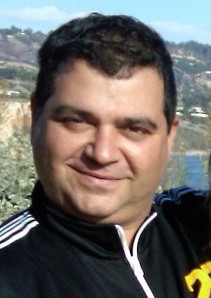 The spirit of digital cinema is small, simple, compact, fast, efficient and immediate. As a business, we like to think that we encompass those traits as well. Film has had 100 years to advance to where it’s at right now, while digital cinema has had just five years. This is still a period of discovery, and that’s where we come in.
The spirit of digital cinema is small, simple, compact, fast, efficient and immediate. As a business, we like to think that we encompass those traits as well. Film has had 100 years to advance to where it’s at right now, while digital cinema has had just five years. This is still a period of discovery, and that’s where we come in. HD Camera Rentals, established in 2005, is a full-service rental house focused on customer service by offering leading-edge cameras and equipment and providing creative, flexible and affordable solutions for any sized project, whether a feature film, commercial, corporate identity package or music video. Located at 4117 W. Jefferson Boulevard in Los Angeles, the firm can outfit an entire shoot, including camera packages and a full range of supporting accessories as well as a staff of experienced technicians. HD Camera Rentals can be reached at (323) 737 1314 or info@hdcamerarentals.com, and online at www.hdcamerarentals.com. Find HD Camera Rentals on Facebook at www.facebook.com/hdcamerarentals.
Here is more news and information about HD Camera Rentals
NOTE: Wolfe News Wire is an online source for news and information about noteworthy companies and organizations. We invite you to share this content and/or leave a comment. Background info and past news items from a specific organization can be found by clicking the side logos. For more info, please email info@wolfenews.com. Thank you!
©2015 Wolfe Public Relations. All Rights Reserved.






























